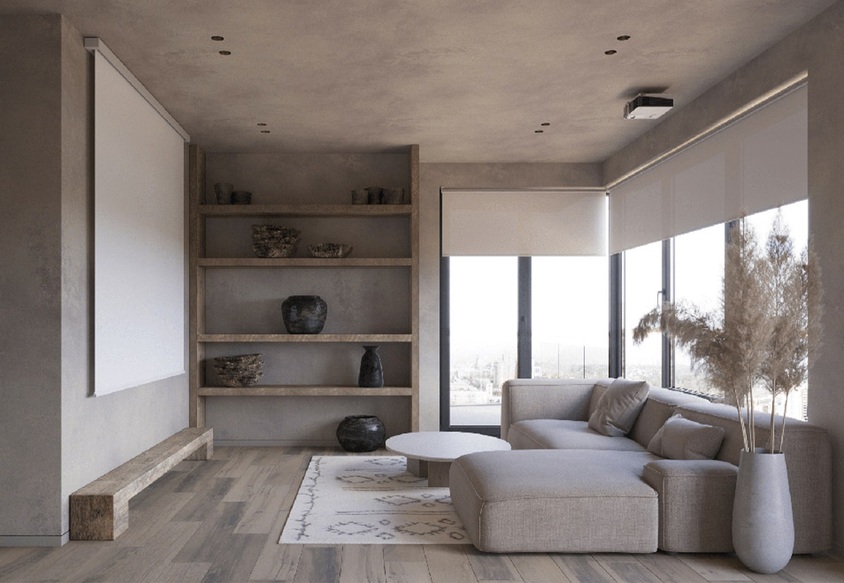At the Living

Source: Prodan Design
Wabi-sabi living interiors embrace the art of imperfection and the beauty of simplicity, creating a space that exudes a unique charm and tranquility. In this particular setting, the design elements come together to create a harmonious balance of rustic elegance.
The concrete wall and ceiling serve as a raw canvas, their imperfect textures and subtle cracks adding character to the room. Instead of concealing these imperfections, they are celebrated as a testament to the passage of time, making each mark a story to be told. Against the concrete backdrop, a projector screen emerges like a portal to another world, inviting you to immerse yourself in the magic of cinema. The weathered wood bench beneath it offers a touch of warmth, its worn surface telling stories of countless gatherings and shared memories.
Beneath your feet, unfinished wood flooring adds to the organic feel of the space. Its natural grain and occasional knots provide a sense of authenticity that perfectly complements the wabi-sabi aesthetic. A weathered wood pottery display shelf, carefully placed against the concrete wall, showcases a collection of pottery pieces. Each one is unique, bearing the marks of its creator and the passage of time. Together, they tell a story of craftsmanship and the beauty of imperfection.
A simple design floor mat, with its understated patterns, rests beneath a muted grey sofa. The sofa, with its soft, worn-in cushions, invites you to unwind and find comfort in simplicity. A white rounded coffee table stands at the center, its smooth surface a stark contrast to the rugged textures around it.
A concrete vase of Pampas grass sits atop the coffee table, its delicate plumes dancing in the gentle breeze from an open window. Speaking of the window, it is large and unadorned, allowing natural light to flood the room during the day and revealing a view of the ever-changing world outside. A roll-down roller blind, when needed, adds an element of control, its muted tones seamlessly blending with the surroundings.
This wabi-sabi living interior is a testament to the beauty of embracing imperfection, appreciating the passage of time, and finding serenity in the simplicity of design. It's a space that tells stories, evokes emotions, and reminds us of the transient nature of beauty, making each visit a unique and enriching experience.
Individuals who have a deep appreciation for natural materials such as wood, concrete, and weathered textures will find this design appealing. They see the beauty in the imperfections and textures of these materials. The wabi-sabi aesthetic is visually pleasing to many. Its use of natural materials like wood and stone, muted colour palettes, and an emphasis on texture creates a calming and harmonious environment. The beauty of wabi sabi lies in the simplicity and the patina of time.
To achieve this Wabi Sabi theme, you will need to:
- Natural Materials: Use natural materials like wood, stone, concrete, and clay. These materials should show signs of wear, age, or weathering, as these imperfections are central to the wabi-sabi aesthetic.
- Muted Colour Palette: Stick to a muted and earthy colour palette. Soft, neutral tones like beige, grey, and muted greens or blues create a calming atmosphere.
- Texture and Patina: Incorporate textures that tell a story. Weathered wood, cracked ceramics, and rough-hewn textiles add depth and character to the space.
- Embrace Imperfection: Celebrate imperfections in decor. Choose furniture and decor items that are aged, have visible flaws, or show signs of wear. These imperfections are seen as beautiful and unique.
- Minimalism: Keep the space uncluttered and minimalist. Avoid excessive decoration and ornamentation. Less is more in wabi-sabi design.
- Handmade and Unique Pieces: Incorporate handmade and one-of-a-kind items. These can include handcrafted pottery, artisanal textiles, and vintage or antique furniture.
- Natural Light: Maximise natural light in the space. Large windows and open layouts help create a connection to the outdoors.
- Indoor Plants: Integrate indoor plants or fresh flowers to bring a sense of nature indoors. Simple, unpretentious planters work best.
- Unfinished Surfaces: Leave some surfaces unfinished, such as exposed brick or concrete walls. These raw elements add to the authenticity of the space.
Avoid:
- Perfection: Avoid anything overly polished or perfect. Wabi-sabi celebrates the beauty of imperfection, so don't try to conceal natural wear and tear.
- Excessive Clutter: Steer clear of clutter and excessive decoration. Each item in the space should serve a purpose or have a meaningful story.
- Bright and Bold Colours: Avoid bright and vibrant colours. Stick to muted, understated tones.
- Mass-Produced Items: Try to avoid mass-produced, generic decor items. Instead, focus on unique and handcrafted pieces.
- Overly Designed Furniture: Avoid overly designed or ornate furniture. Look for pieces that are simple in form and function.
- Glossy Finishes: Shiny or glossy finishes should be minimised. Opt for matte or natural finishes that reflect the authenticity of materials.
- Excessive Technology: Minimise the presence of excessive technology and gadgets. Keep the focus on natural elements and simplicity.
- Overly Symmetrical Arrangements: Avoid overly symmetrical or perfectly balanced arrangements. Embrace asymmetry and organic layouts.
- Overdecorating with Plants: While indoor plants are encouraged, don't overcrowd the space with too many plants. Keep it simple and unobtrusive.
- Forced Aged Look: Avoid artificially distressing furniture or decor items to create an aged look. Authenticity is key in wabi-sabi design.